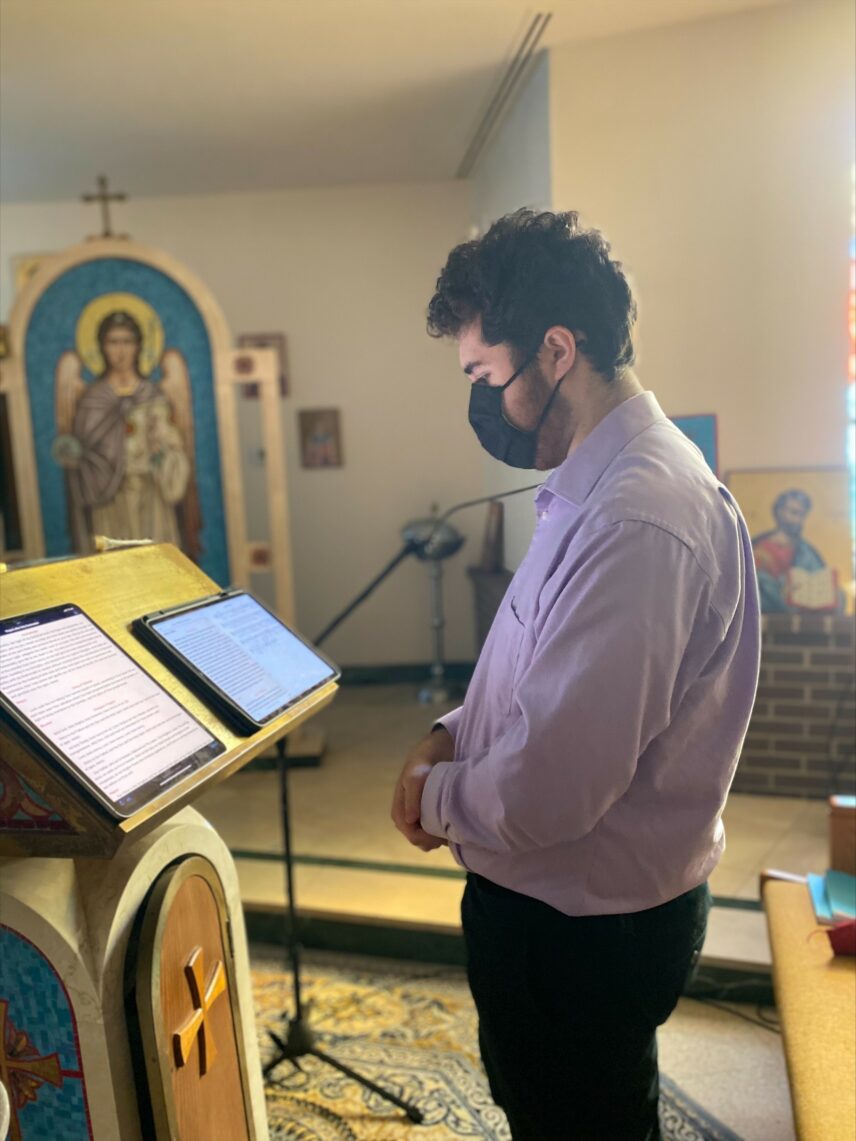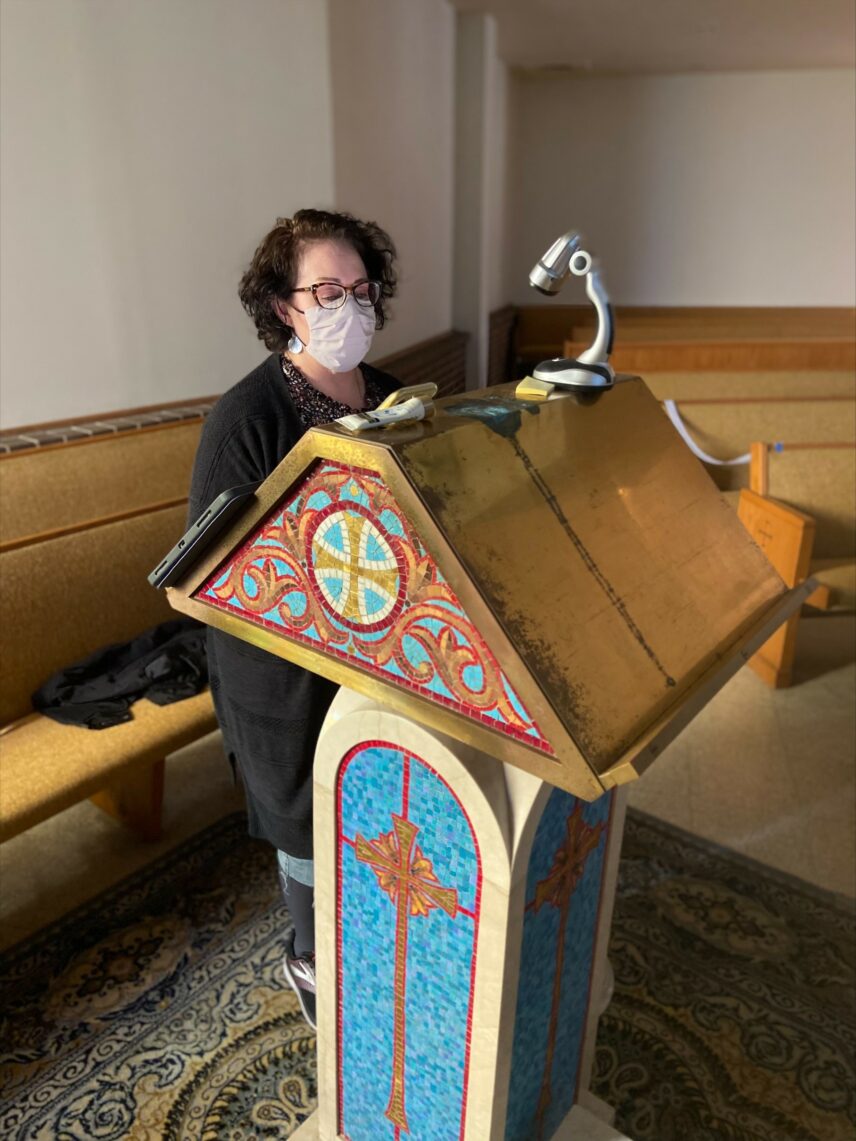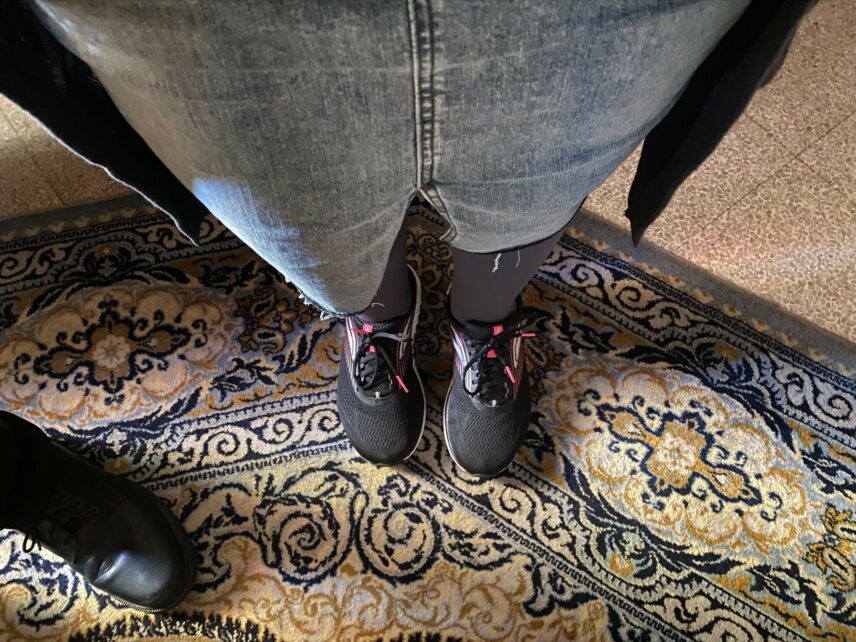Article begins
On a cold Sunday morning in January, I arrive at church at 7:45 a.m. for an 8:00 a.m. Orthros (Matins) service. I open a back door behind and to the right of the altar and enter a small passage where women are permitted, though we cannot enter the altar itself. I greet the priest, who is making his own preparations, and make my way through the sanctuary to stand at the chanter’s stand (analoghion) on the other side of the altar. Later, the priest will turn on the lights to signify that we have begun the Divine Liturgy. For now, the only illumination comes from daylight streaming through the stained-glass windows, a few candles flickering in red glass votives above the tiled mosaic icon screen that divides the altar from the sanctuary, and the glow of the iPad I use to read the texts and music for the hymns. With incense drifting from the altar, the service begins, and a few minutes later I intone the first hymn of Orthros, using Grave Mode today: “God is the Lord, and He revealed Himself to us. Blessed is he who comes in the name of the Lord.” My morning’s work will continue for the next three hours with almost constant chanting in response to the priest, and it will carry on even after the liturgy has ended, when I chant a recessional hymn while parishioners file out and then recite the thanksgiving prayers that follow the liturgy.
The above scene depicts a typical day in the current phase of an apprenticeship in Orthodox Christian liturgical music, also known as Byzantine chant, that I began in 2013 in East Central Illinois. Apprenticeship is de rigeur for most ethnomusicologists: how better, after all, to grasp the aesthetic values of a musical tradition than to learn from a master? Yet apprenticeships are challenging to arrange, as much depends on whether our interlocutors consider their music to be teachable to outsiders, and whether they consider us to be suitable learners and bearers of their musical traditions.

In earlier research on traditional vocal music on the Greek island of Skyros, I sought such an apprenticeship in vain. Skyrians told me, “Our music can’t be taught, it must be lived.” They seemed to connect their songs to an intimate sense of belonging to their island; as an outsider, I was simply not a possible bearer of this knowledge. The women singers I most wanted to work with described hearing their parents sing the songs around a laden feast-day table; they themselves were not taught the music, but rather lived it. Yet I discovered another form of apprenticeship on Skyros, one that had been open only to men. Several men described having apprenticed in their youth with a liturgical chanter in one of the island’s churches. Given that Skyrians described even their folk melodies as “Byzantine,” an apprenticeship at the chanter’s stand offered a path to musical knowledge that stood in contrast to that of women.
Given this history, I was surprised to be invited to join the all-male chanters at a church on Skyros, after the priest had overhead me chanting under my breath during a service and complimented my limited abilities. In the role of “second” (defteros) at the chanter’s stand the next Sunday, I read or chanted passages when the chanter pointed at me to do so, and I overheard him assessing my proficiency in conversation with other chanters. While time did not allow me to repeat the experience, my taste of apprenticeship that day showed me not only how male singers came to learn the Byzantine aesthetic at the heart of liturgical and folk music on Skyros, but also that a singer’s ability to produce the desired aesthetic often outweighed other constraints, such as gender.
As my research has developed since then, the work of musical apprenticeship has centered on demonstrating command of the aesthetic at the heart of liturgical music—an aesthetic that, in spite of being open to women, was not developed with women’s voices in mind. Navigating the tension between the potential of Orthodox musical theology to transcend gender and the gendered specificities of liturgical music in practice, remains my greatest challenge.
Music as sounded theology
Music in Orthodox Christianity is sounded theology—that is, the primary means by which worshippers encounter theological principles. Orthodox theology centers on the sensory experience of spiritual beauty, and therefore musical aesthetics are every bit as important as the words of hymns—especially considering that Orthodox services are largely sung or intoned rather than spoken. In Byzantine chant, a system of eight musical modes (ihi) structures the hymns, some of which are sung to set melodies and others of which can be sung in varying modes, according to an eight-week cycle that progresses through all the tones before returning to the starting point.
Most Greek Orthodox parishes employ chanters (paid or volunteers) as expert leaders in liturgical music; in fact, the office of head chanter, or Protopsaltis, is considered to be a minor ordination. Chanters gather around the chanter’s stand (analoghion), which has a rotating top designed to hold multiple hymnals. One chanter or group of chanters sings the melody, while another chanter or group of chanters holds a continuous supporting drone (ison) below the melody.
Acoustically, the resonant combination of melody and drone is the most striking aspect of the Byzantine musical aesthetic. The drone usually centers on the tonic, or starting note, of each of the eight modes. In some modes, that note will move to the subdominant or dominant note of the scale, and sometimes the leading note, to support the melody as it moves through the scale. The tonic, however, remains central, as one of the drone’s functions is to give the chanter who is chanting the melody a place to come back to and retune if necessary. The drone also provides pleasing resonances: just as the domes of a Byzantine church amplify sound, so too does the drone augment and support the lead voice, making chanting physically less exhausting. A good drone can enhance even a mediocre chanter, reassuring those who have little aptitude but still wish to offer up their voices to God. This reflects a theology centered on the human scale of worship, which is intended to meet people where they are.
The antiphonal texture of liturgical music also reflects theology: call-and-response exchanges between priest and congregation, priest and chanters, or two separate groups of chanters, call to mind the metaphorical dialogue between God and humanity. Antiphony, combined with a modal system that changes regularly, as well as a linguistic mix of Greek and English, leaves both worshippers and church musicians caught up in a sonically engrossing, emotionally resonant, highly dynamic, and often improvisational scene during services. Such liturgical beauty led Russian ambassadors to the Agia Sophia church in Constantinople to remark in the year 987, “We knew not whether we were in heaven or on earth.”

The gendered aesthetic of Byzantine chant
While the above description holds universal appeal, Byzantine chant has, at least for the past couple of centuries in Greece and the Greek American diaspora, largely remained the domain of male voices. In Greek American churches during the twentieth century, women’s voices predominated not at the chanter’s stand, but rather in Western-style choirs singing harmonized arrangements of Byzantine melodies. During this period, a gendered division of labor emerged whereby male chanters performed the Orthros service, with its changing hymns and modes, while the predominantly female choirs sang during the Divine Liturgy, which contains fewer weekly changes and more predictable liturgical responses. While this division of labor held for decades, these distinct musical communities clash aesthetically in moments of overlap: when chanters and choir alternate hymns antiphonally or even attempt to sing together, there is no way to reconcile choral harmony in thirds with a Byzantine drone pitched at an interval of a fourth below the melody.
The literal—and metaphorical—dissonance between chanters and choirs increased during the so-called neo-Byzantine revival, which began in Greece and took hold in the United States by the late 1980s and early 1990s. Based on an interest in the Byzantine aesthetic expressed in both liturgical and folk music, iconography, and other traditional elements of Eastern Christianity, the revival in the United States effectively centered mostly male chanters over predominantly female choirs, with Byzantine-style hymns claiming more space in the liturgy as well as in the Orthros. While the neo-Byzantine revival encouraged people of any gender to chant, the history of these two musical communities produced a gendered generational gap that remains a source of tension in many parishes.
Learning to chant in East Central Illinois
It was this tension I sought to understand when I began my research in East Central Illinois. I wanted to learn how small churches, such as my own adopted parish in Champaign, Illinois, weathered the neo-Byzantine revival. Choirs had allowed women to participate in liturgical life when they had been excluded (in practice, if not in doctrine) from the chanter’s stand; the shift back to an emphasis on chanting, in small churches with few resources, would allow me to understand the value of women’s voices as well as the power of the Byzantine aesthetic, centered on melody and drone.
Early in the project, I conducted participant observation in area churches and interviewed clergy and church musicians. Gradually, however, the work began to shift toward deeper participation in chanting at my home church in Champaign. I still sang in the choir, but also occasionally assisted at Orthros services. One Sunday during coffee hour, the senior chanter, a Greek man in his early nineties, approached me and asked in Greek, “Don’t you chant?” When I replied that I did, after a fashion, he formally invited me to assist him. While I delayed in fully participating until after my son began to apprentice at the age of 13, this invitation surprised me almost as much as the one on Skyros had: within a tradition rooted in patriarchy, an apprentice’s potential to produce the correct musical aesthetic (especially if they knew Greek) appeared to outweigh gender constraints.

In the years that followed, as the head chanter’s health declined, my son and I, along with other occasional chanters drawn from the university community, served at Orthros, after which the choir took over for the liturgy. My apprenticeship at this stage felt chaotic. Historically, chanters in Greek American churches have used multiple service books at Orthros, none of which contain music notation. Chanters either learn the melodies by ear, or consult yet other books with Byzantine musical notation and Greek texts. I do not read Byzantine notation; this is another knowledge gap between chanters and choir members used to Western staff notation. Eventually, my son and I adopted a mobile app that showed liturgical texts in Greek and English, along with sheet music in both Western and Byzantine notation. Yet this development involved another learning curve, since my sight-reading skills were poor compared to those of my pianist and composer son; preparing for an hour-long Orthros service often took me two hours at home. The slight advantage my years of ear knowledge and command of Greek had given me now gave way to my son’s abilities, and soon it was clear that I was apprenticing under him.
Setting the pitch was another challenge in my apprenticeship and, for women, perhaps the most fraught aspect of the Byzantine aesthetic. While anyone can theoretically learn to chant, the Orthodox priesthood is entirely male. The priest starts every service, which means that he sets the first pitch. For some reason, many Greek Orthodox priests use a high tenor range, which is too low for most women to sing, but also too high for us to double at the octave. Additionally, the use of a woman’s high “head voice” is not in keeping with that deep and resonant Byzantine sound; even professional recordings of women chanters feature a thinner sound with closer intervals, since the melody and drone are often in the same octave. Changing to a more suitable pitch is also challenging, given the liturgy’s antiphonal texture. The Byzantine aesthetic is built not just on melody and drone, but also on the musical dialogue between voices. Constantly changing the pitch is disruptive—assuming a chanter can do it correctly. In the beginning, my knowledge of the eight-tone system did not allow me to change pitches on the fly while preserving the correct intervals. As a result, I either strained my voice by singing too high, or tried to change and sang entirely out of mode. Being open to such mistakes and expecting slight (or profound) humiliation is, for me, a hallmark of fieldwork and of apprenticeship, just as developing the ability to pause long enough to retune is a sign of mastery.
Chanting during the COVID-19 pandemic
Such was the stage my apprenticeship had reached when the COVID-19 pandemic began in 2020. For the first two months, the church went online, using YouTube and Facebook Live to stream services. Only the priest and his wife attended in person, so she was thrust into the role of chanter with no warning. When the church received permission to open again with limited numbers, my son and I resumed our places at the chanter’s stand, with masks. Vocalizing was limited to slow the spread of respiratory particles, so the choir was not singing, and the congregation was asked to avoid vocalizing loudly. We were effectively the only chanters.
At this time, the work intensified as the priest in nearby Decatur had to remain in quarantine. My parish priest joined others in the area in a rotating substitute schedule of Saturday services for the Decatur parishioners, and I filled in as a chanter on several Saturdays. Not long after, I also began chanting at monthly Saturday liturgies in the St. Barbara Chapel in Danville, Illinois, an auxiliary parish to Three Hierarchs. So, while teaching university classes remotely, I was busier than I had ever been before, in my new role as an essential liturgical worker. Holy Week and Easter 2021 represented a milestone, with my son and I chanting at more than 15 services, each between one and three hours long.
My musical apprenticeship continues, as does the pandemic. Illinois remains under an indoor mask mandate in the face of recent variants, and so we continue to chant with masks. My son invited some fellow college students to join us, and has taken up the work of helping them to learn chanting. He reminds me that I know more than I think I do, and certainly my confidence has grown, as have my sight-reading and retuning skills. One day last month, I even found myself helping the priest to reset his pitch when he lost the musical mode.
Work now involves scheduling as many in-person classes as possible to accommodate chanting an early weekday service before driving an hour to campus. Being dressed for church no longer always means the nicest outfit, since I have to be able to breathe and stand for three hours; I have long since abandoned fashionable pumps in favor of running shoes. On mornings when I am chanting alone, without my son, I also must time my bathroom breaks. Most Orthros services contain a long dismissal prayer in the middle and I have timed it such that I know exactly on which saint’s name I will make it back into the sanctuary. My other break comes during the sermon.
My workspace consists of the brass chanter’s stand where I set my iPad open to the Digital Chant Stand app. Next to the stand is a pillar that holds a portable fan, tissues, hand lotion, water bottles, and often my glasses, as they fog up over my face mask. Having once felt excluded or an intruder in that space, the chanter’s stand has become a home away from home. Yet it remains a place of ritual authority (though not nearly as formal or ritually bounded as the altar, a space still off-limits to me). Part of the work of musical apprenticeship has been to figure out what ground I have to stand on at the chanter’s stand. Some of that ground has to do with gender and other kinds of belonging, but much of it, as I have learned, has to do one’s ability to voice the aesthetic, to produce the sound that embodies the meaningful emotional and spiritual worlds that people yearn to experience in the liturgy.

